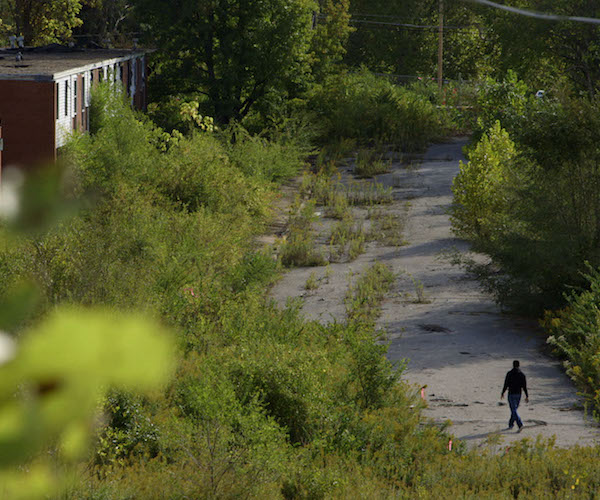Film Review: “Where the Pavement Ends” — The Roots of Racism
What is distinctive about Jane Gillooly’s superb documentary is its patient unfolding of the history of discrimination in a specific area.
Where the Pavement Ends, directed by Jane Gillooly. Screening at the Institute of Contemporary Art in Boston on October 21 at 3 p.m.

A scene from “Where the Pavement Ends.”
By Tim Jackson
August 9, 2014 in Ferguson, Missouri; 18 year-old Michael Brown Jr. was shot and killed by a young police officer named Darren Wilson, who claimed he had been attacked by Brown. When Brown and his friend Dorian Johnson ran, Wilson chased them down. He fired twelve times at Brown — hitting him with six bullets and fatally wounding him. Witnesses claimed Brown cried out “My hands are up, don’t shoot.” Ferguson exploded and angry protests ensued, turning the town into a contemporary symbol of resisting black oppression and injustice. That incident — along with the earlier killing of Trayvon Martin in 2012 and Eric Garner in 2014 — led to the Black Lives Matter movement.
Director Jane Gillooly grew up in Ferguson, which is a suburb of St. Louis. Her documentary Where the Pavement Ends is a superbly constructed look at the roots of racial division in all-white Ferguson and the neighboring all-black community Kinloch. Systemic segregation was generated, intentionally, by setting up a barrier between the two towns. The border line was not removed until the late ’70’s.
In her previous film, Suitcase of Love and Shame, Gillooly used two-track audio tapes discovered in a suitcase to reconstruct an affair between a man and woman. Images of found objects and locations were employed, along with excerpts from hours of audio recordings. Her approach in this new film is similar. Often we’re simply looking at locations, particularly at the border which had rendered passage between the two cities all but impossible: it becomes a powerful metaphor for the division of the races in America. Gillooly also surveys the region through use of archival footage, which offers glimpses of houses, streets, and landscapes. Audio transcripts from a court case that examined the deliberate separation of the races provide the film with a historical reference for its investigation.
Once the history of the location has been established, film probes deeply into perceptions of racial identity; citizens both black and white reflect on the checkered history of the townships. Conflicting ideas of community, white privilege, systemic prejudice, and fear are explored. This meditation leads to a replay of the killing of Michael Brown.
What is distinctive about Gillooly’s film is its patient unfolding of the history of discrimination in a specific area. Individuals are given time to voice their experiences and memories. The result of this patient exploration is not only a passionately human portrait of Ferguson and its residents. We are exposed to a microcosm of the attitudes and institutional policies that have reflected (and still reflect) America’s deeply embedded racism. By immersing us in this world, Where the Pavement Ends brings us closer to understanding the humiliation and misfortune that led to a national tragedy.
Tim Jackson was an assistant professor of Digital Film and Video for 20 years. His music career in Boston began in the 1970s and includes some 20 groups, recordings, national and international tours, and contributions to film soundtracks. He studied theater and English as an undergraduate, and has also has worked helter skelter as an actor and member of SAG and AFTRA since the 1980s. He has directed three feature documentaries: Chaos and Order: Making American Theater about the American Repertory Theater; Radical Jesters, which profiles the practices of 11 interventionist artists and agit-prop performance groups; When Things Go Wrong: The Robin Lane Story, and the short film The American Gurner. He is a member of the Boston Society of Film Critics. You can read more of his work on his blog.
